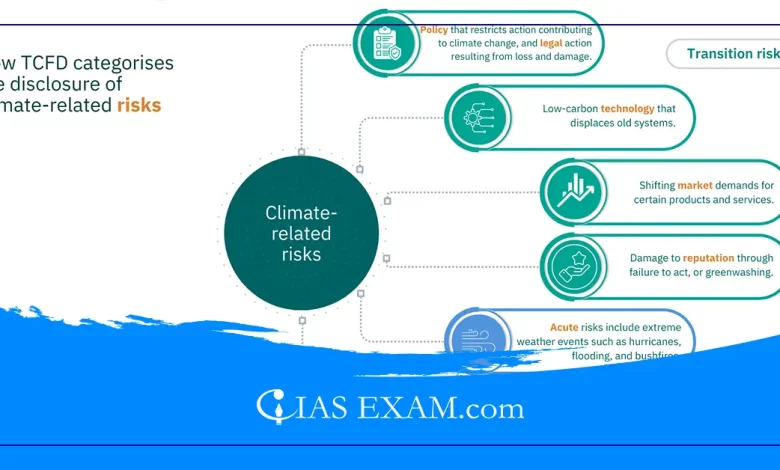Daily Current Affairs for UPSC
Disclosure Framework on Climate-related Financial Risks, 2024
Syllabus- Environment and Conservation [GS Paper-2]

Context
The Reserve Bank of India (RBI) has recently released a draft Disclosure Framework on Climate-related Financial Risks, 2024 for banks to follow.
About
- The regulated entities i.e., banks are meant to reveal statistics approximately their climate associated with economic risks and opportunities for the users of economic statements.
- It recognizes the importance of the environment and its long-term impact on businesses and the economic system as a whole.
What are Climate-associated Financial Risks?
- The RBI has defined climate-related economic dangers as the potential dangers that could rise up from weather change or from efforts to mitigate climate trade, their associated impacts and monetary and financial consequences.
- It can affect the economic region through a huge channel i.e., physical risks and transition dangers.
- Physical Risks: It refers back to the financial costs and financial losses as a consequence of the increasing frequency and severity of intense climate exchange-related weather occasions.
- Impact on REs: Expected coins flowing to the REs from an exposure may be harassed at the incidence of a local / regional climate event.
- Chronic flooding or landslides can also pose a threat to the value of the collateral that REs have taken as security against loans.
- Severe climate events may damage a RE’s owned or leased physical assets and statistics centers, thereby, affecting its ability to offer monetary offerings to its customers.
- Transition Risks: It refers back to the dangers springing up from the system of adjustment towards a low-carbon economic system.
- A range of things affects this adjustment, which include modifications in climate-related policies and policies, the emergence of newer technology, shifting sentiments and behavior of customers.
- The process of transition i.e., lowering carbon emissions may additionally have a substantial effect on the economic system.
About the Framework
- All India economic establishments, and top and higher layer NBFCs will need to begin to provide statistics on governance, approach, and chance control approach from 2025-26 and begin disclosure metrics and goals from 2027-28.
- Banks might be mandated to reveal the ones weather-associated dangers which have a relation to their financial balance.
- The revelation will foster an early evaluation of climate-related monetary risks and opportunities and also facilitate market area.
Organisations under the Purview
- All scheduled commercial banks (excluding local area banks, payments banks and regional rural banks).
- All Tier -IV primary (urban) and cooperative banks (UCBs).
- All top and upper layer non-banking financial companies.
Disclosure by the REs
- Identified weather-associated risks and possibilities over short, medium and long time.
- The impact of weather-associated risks and possibilities on their corporations, strategy and financial planning.
- The resilience of the RE’s approach considering the one-of-a-kind weather eventualities.
Significance
- There is an urgent want for a better and steady disclosure framework for regulated entities, without which the economic risks can lead to mispricing of belongings and misallocation of capital.
- This basically led to a preferred disclosure framework on weather associated economic risks.
Source: The Hindu
UPSC Mains Practice Question
Q.Explain how Climate-associated Financial Risks affect India’s Economy? (200 words)





.png)



